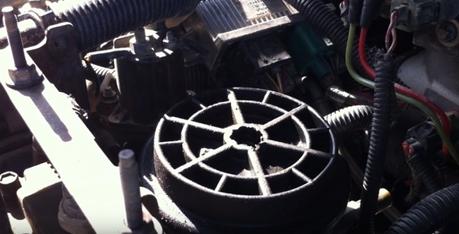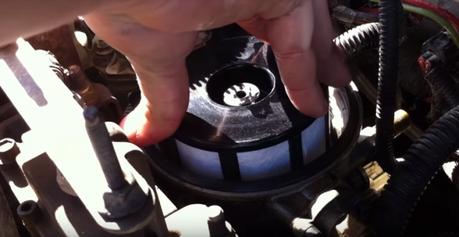Fuel filters are designed to prevent particulates from entering the combustion system. Particulates may include anything that is "solid" and can damage or clog up the system. As such, most 7.3 Powerstroke engines come with more than one filter to manage the different sizes of particulates and ensure that only fuel reaches the engine.
Here is the list of the top-rated 7.3 Powerstroke Fuel Filters.
The Best Fuel Filters for 7.3 Powerstroke Reviews
This is the K&N PF4000 Fuel filter for 1999-2003 7.3 Power stroke applications
Performance
The K&N PF4000 series is a filter designed for fast flow rates and as such are built using a high strength carbon steel housing with a high performance rolled seam. The material used is a cellulose glass, and the overall width is 6.563" diameter and 4.313" long.
Fitment
- 1999-2003 Ford E350 Club Wagon, Ford E350 Econoline Club Wagon, Ford E350 Super Duty,
- 1999-2003 Ford E450 Econoline Super Duty, Ford E450 Econoline Super Duty Stripped, Ford E450 Super Duty, Ford E450 Super Duty Stripped Chassis,
- 1999-2003 Ford E550 Econoline Super Duty, Ford E550 Super Duty, Ford Econoline Super Duty, Ford Excursion,
- 1999-2003 Ford F250 Super Duty, Ford F350 Super Duty, Ford F450 Super Duty, and Ford F550 Super Duty models.
Recommendations
A standard replacement filter for various 1999-2003 applications.
This is the Ecogard XF58282 fuel filter for various 7.3 Power stroke applications
Performance
The Ecogard filters are designed to combat water as well as particulates and provide excellent water separation characteristics. This model comes with the original inlet and outlet connections, so you get a fast and easy installation. This model is a replacement part for FRAM CS8629A Purolator F59292 WIX 33818 Motorcraft FD4596 OE FD4596.
Features
- 1999-2003 Ford F-250 Super Duty,
- 1999-2003 Ford F-350 Super Duty,
- 2000-2003 Ford Excursion,
- 1999-2003 Ford E-350 Super Duty,
- 1998-2002 Ford E-350 Econoline Club Wagon,
- 1998 Ford E-350 Econoline,
- 2003 Ford E-350 Club Wagon.
Recommendations
A great filter delivers good lasting power and performs well under stress.
This is the Motorcraft FD4596 dual element filter for 1999-2003 7.3 Power stroke applications.
Performance
This filter has been tested in temperature ranges between -40 to 250 degrees Fahrenheit. This is a leak-resistant filter kit and comes with excellent corrosion resistance, flow restriction resistance, and performance under extreme pressures.
Fitment
- 1999-2003 F250, F350, F450, F550, E-Series
Recommendations
Perhaps one of the higher performance models on the market, and a great value for the money filter.
This is the Ecogard XF55055 fuel filter for 1994-1998 7.3 Power stroke applications
Performance
This is another great Ecogard product, it comes with all the standard features of their filter ranges, including original locations for the inlets and outlets and is very easy to install. This model is used on the olede3r applications and is a replacement filter for FRAM CS7715A Purolator F55055 WIX 33817 Motorcraft FD4595 OE FD4595.
Fitment
- 1994-1997 Ford F-350,
- 1994-1996 Ford F-250,
- 1997 Ford F-250 HD,
- 1995-1998 Ford E-350 Econoline,
- 1995-1997 Ford F Super Duty,
- 1995-1998 Ford E-350 Econoline Club Wagon,
- 1996-1998 Ford Econoline Super Duty,
- 1994-1997 Ford F59.
Recommendations
A great filter for you 1994-1997 applications, just make sure you get your model right.
This is the Motorcraft FL1995 dual element fuel filter for 1993-2003 7.3L Power stroke applications.
Performance
This Motorcraft filter has been tested in temperature ranges between -40 to 250 degrees Fahrenheit. As with all Motorcraft filters, this is a leak-resistant filter kit and comes with excellent corrosion resistance, flow restriction resistance, and performance under extreme pressures.
Fitment
- 1999-2003 Ford-F250, F350, F450, F550, E-Series, Excursion
Recommendations
A great versatile filter and works best with 1999-2003 applications, this is one of the top rated filters of all times.
Understanding Size
A filter is used to stop particulates from entering the engine, as such, there are different sizes to these particulates, and some are microscopic. Here are a definition and a comparison of different particulate sizes so you can fully understand the differences in sizes.
In the automotive filter industry, the common unit of measurement is the micron or micrometer.
- One micron is equal to 40 millionths of an inch (0.00004″).
- A primary fuel filter must remove sizes ranging from 10 to 15 microns (0.0004″ to 0.0006″).
- A secondary or final fuel filter must remove sizes ranging between 3 to 5 microns (0.00008″ to 0.0001″).
- The human eye cannot see particles smaller than 40 micrometers (0.0016″).
- A grain of salt is around 100 micrometers.
- A human hair is around 70 micrometers in diameter.
- A single grain of talcum powder is about 10 micrometers.
As you can see, particulates that the filters deal with are extremely small, as such, you might not see the buildup initially, but over time you will see a steady buildup on the filter. This build up is called plugging and comes from the fuel used, not just from external contaminants that night invade the system. Here is what this build up is primarily made of:
Asphaltene
All diesel fuels contain Asphaltene. The word "asphaltene" was coined by Boussingault in 1837 when he observed that the distillation residue of some bitumens had asphalt-like properties. Their size ranges between ½ to 2 microns, and these particles do not affect the engine or the injection system, they do however stick to the filter and over time plug it up. As such, Asphaltene, which is not harmful, and is part of the diesel fuel ecology, act as unnecessary filter plugs. The Asphaltene residue accumulation looks and feels like a black tarry coating.
Diesel Paraffin Wax
Another substance that is found in all diesel fuels is Paraffin wax. This is a harmful substance but is also part of the diesel ecology. When the diesel temperature falls to what is termed the cloud point, the wax form into crystals that precipitate out of the liquid and form a "cloudy" appearance. The more wax in the filter, the less the filter can contain, and this residue passes into the fuel line and accumulates. It's just like cholesterol in an artery. The fuel line is coated with a solid wax surface that slowly builds up restricting the flow of diesel to the engine, eventually choking the engine. You can see this accumulation rise in the form of a yellow waxy substance that covers the filter.
Clean versus Dirty Filters
You need to pay close attention to your fuel filter at all times. Especially if you are a long route driver that performs hours of on-road and off-road driving. Also, if you drive in colder climates, the possibility of paraffin wax cloud is greater than in hotter climates. As such, you need to check your filter frequently and replace it when you start to see a black and yellow coating form over a large area of the filter.
Another issue with filters is their location, where certain filters are exposed to rougher environmental conditions when they are placed under the chassis or in certain engine bay areas. A sealed filter unit is great, but contaminants will find a way in if the seals are not exceptionally perfect.
Warnings
Most vehicles come with a diesel pre-warming device, however, don't expect this to prevent your fuel from freezing in colder locations, consider living in the North or Alaska where cold weather is standard, and in winter it goes into the double-figure minuses. Add to this wind chill, and you will have frozen fuel lines, and the cloudy wax will appear daily.
Other attributes of cold weather are water condensation; this can be prevented when using certain additives.
Consider that most diesel sources provide you with summer grade diesel, unless you live in Alaska, and there you get winter grade all year round.
For warmer climates and in the summer, never add a performance enhancement product to your fuel, this could be detrimental to your engine, and you need to consult with your manufacturer before you add any kind of aftermarket additive.
Final rule; only buy fuel from a recognized source. Otherwise, you risk destroying your engine from bad fuel.
How to change a 7.3 Power Stroke Fuel Filter?
- Locate the fuel filter housing towards the front of the engine centered in the valley.
- Locate the metal fuel filter housing drain tube.
- On 1994 - 1997 engines the tube travels from the fuel filter housing vertically down the passenger side front of the engine block, ending just below the valve cover.
- On 1999 - 2003 engines, the tube is on the side, not front, of the engine block.
- Take a 26" long piece of 5/16" tubing and attach it to the drain tube on one end and a pan on the other.
- Move the yellow filter housing lever on the left side 90 degrees clockwise.
- Drain the fuel, around 2 pints.
- Remove the fuel filter cap using a screwdriver.
- Remove the old filter and the fuel filter cap gasket.
- Immerse the new filter cap gasket in diesel and install it on the housing. Make sure the v shape faces the lip and not the cap.
- Immerse the new filter in diesel and place it into the housing.
- Tighten the filter cap using the screwdriver.
- Close the fuel filter housing drain valve and remove the hose.
- Start the truck and check for leaks.



